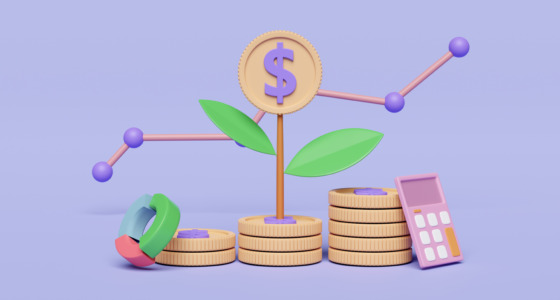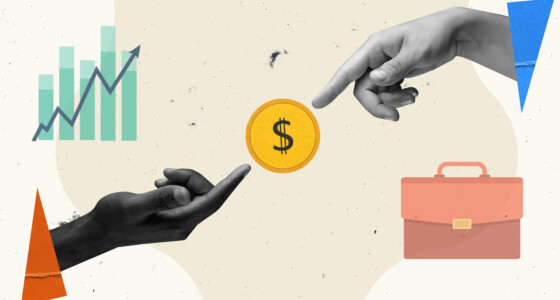

Passive income is highly sought-after and highly misunderstood at the same time. Some people mistakenly believe that it is easy and requires no upfront work. But none of it is true.
Now that it’s been established that passive income is not a “set it and forget it” venture, let’s move on to the topic at hand. Here are several passive income streams that aren’t too complicated but have the potential to bring in the results.
In recent years, there has been a steadily rising interest in passive income. The chart below is taken from Google Trends. Surprisingly, the highest peak in interest was in January 2022. The query “passive income” wasn’t that highly searched even when quarantine and restrictions affected people all around the world.
1. Dividend stocks
As public companies generate profit, a portion of it goes to shareholders each quarter. Mature, well-established companies are the most likely to pay good dividends, which is 2%-6% on average. Because dividends are paid per share, the more shares you have of a particular stock, the higher the return.
Investing in dividend-yielding stocks requires little to no ongoing effort (unless you decide to buy more shares of the same stock, diversify, or sell altogether). But the tricky part is choosing the right stock(s) for your upfront investment. Consider the following:
- Long-term profitability of the company
- Growth expectations
- Debt-to-equity ratio
- Broader industry and sector trends
It’s generally safer to start with companies that have upped their dividend payments annually for decades. Of course, you can also look into newer, trendier companies that seem to have potential. But determine your risk tolerance and proceed with caution.
2. Indices and Index Funds
Index funds and indices allow you to invest in a collection of dividend-paying stocks (1%-10% yield). They are bought and sold as regular stocks (i.e., as one asset), but you receive a diversified basket of multiple assets. You’ll be paired with a fund manager who builds a portfolio and does the hard work for you. In exchange, they take a cut from the profits.
Index funds are generally highly liquid and fairly inexpensive, which makes them a good choice for the risk-averse. Another benefit is that even if one company in the index reduces or withholds dividends for the quarter, it has a minor effect on the index yield, if any, because there are many constituents. Similarly, indices experience less volatility – except for in recessions, it’s not often that most companies take a dip.
Indices and funds rearrange their holdings as soon as the instrument is proven to underperform. Assessments are held regularly and follow proven formulas.
3. High-yield savings accounts
This is also referred to as investing in a high-yield certificate of deposit. Savings accounts or CDs are offered by banks and take minutes to set up. If your bank offers one and is backed by the FDIC, the FSCS, or a similar entity relevant to your country, consider this point the most straightforward and accessible in the list. Many regulators even provide insurance up to a certain amount.
The main advantage of a savings account is that returns are guaranteed. They don’t depend on the market, company performance, or other variables — you receive a predetermined percentage specified in the agreement.
Savings accounts aren’t the most profitable method, though. The yield percentages generally don’t go higher than 1%, which doesn’t always cover high inflation.

4. Real estate investment trusts

REITs are publicly traded companies that invest in real estate across a range of property sectors. As a REIT investor, you receive dividends from the company’s profits. Legally, REITs are obligated to pay out 90% of their income to shareholders, which often puts their yield percentage above some of the leading indices (as high as 7% and up).
Here are a few types of REITs and the question you need to ask:
- Retail: Is the retail industry financially healthy now, and where is it heading?
- Residential: Is the housing market up? Are there high-profile development projects going on?
- Healthcare: Is the healthcare sector privatized? If so, does it generate profits?
- Office: Is the economy doing well? What is the current unemployment rate?
- Mortgage: What are the interest rates?
The payouts can fluctuate depending on the prosperity of the company and the wider market. REITs have the right to cut the dividend or eliminate it completely, especially in tough economic times.
5. Bond ladders
Bond ladders are portfolios of fixed-income securities that mature at different times but in roughly even intervals.
The staggered maturities make it possible to collect and reinvest your interest payments. Laddering also lowers credit risk because it is spread across the portfolio. Also, there is room for experimenting with reinvestments — for example, the proceeds from a recently matured 1-year bond can be invested in an 8-year bond.
Treasury bonds (<1%-7%) are backed by the government, while corporate bonds are not. So, pick those that match your risk tolerance.
6. Peer-to-Peer lending
Peer-to-peer (P2P) lending is a service where two individuals (lender and borrower) interact directly with each other. Transactions are usually done through an intermediary, which enforces safety policies. The passive income is made through interest charged to borrowers.
Technically, you can lend anything that stores value or has a valuable use case. Most people go the simple route and lend fiat money, but crypto lending has been on the rise for a few years already.
Keep in mind that P2P loans are unsecured. So if your borrower defaults on the loan, you might end up with nothing unless you pursue legal action. To minimize risks, carefully vet your prospective borrowers or choose platforms that do it for you.
7. Affiliate marketing
When you participate in an affiliate program for a company, you receive a commission for any purchase made with your code or through your link. The average affiliate commission is 5%-30%.
This option carries zero risk because you don’t need to invest anything — you simply promote products. It may not amount to a significant income stream unless you have a large online following. Increase the reach of your link or code — first, among friends and family, and then, among a wider audience.
Final thoughts
Any new project, whether it’s investing or setting up an affiliate account, can be daunting to start. Do thorough research on whatever path you plan to take. Also, seek out personal experiences and always start small.
Keep in mind that passive investments don’t pay off right away. Before you have an income-generating asset, you need to put in some time and effort. The best methods often increase their payout over time, so if you manage everything correctly, you should see your passive income grow.









